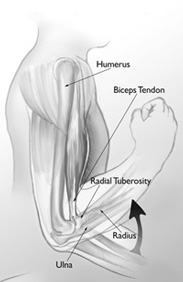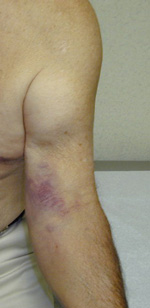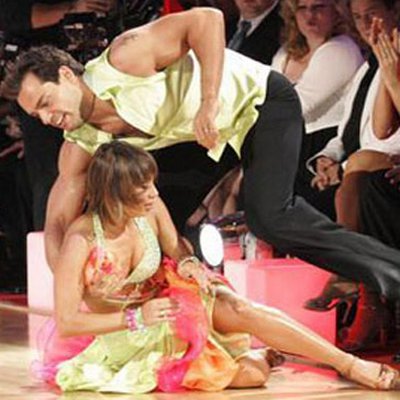Your biceps muscle is located in the front of your upper arm. The name "biceps" literally means "two heads," and the muscle was given this name because it originates from two different tendons around the shoulder area. At the elbow, the distal biceps tendon inserts on a part of the radius bone called the radial tuberosity.
The biceps muscle helps you to flex (bend) your elbow. It also helps you rotate your forearm so that your palm faces upward (think about receiving change from someone); this direction of rotation is called supination (soup-in-AY-shun). If you tear your distal biceps tendon, you lose some flexion and supination strength. Flexion strength is used when we bend our elbow to lift something; supination strength is used when we turn our forearm such as when using a screwdriver.
The tendon usually tears at the elbow when the elbow is forced to straighten against resistance; for example, if you try to lift a very heavy object (furniture, motor vehicle, etc.), you are flexing your elbow while the object is forcing it to extend. The tendon usually tears from the bone. Tears are much more common in men than in women and usually occur in men over age 30 or 40. Smoking and use of steroids is associated with an increased risk.


Many people state that they heard a "pop" when it happened. You might notice a lot of bruising, swelling, weakness, or even a bulge in the upper arm that occurs because the muscle is no longer attached near the elbow. This can be pretty painful initially, but the pain generally resolves over a few weeks.
It's best to see your orthopaedic surgeon as soon as possible. Your doctor will listen to how the injury happened and examine you. Sometimes an MRI is ordered when there is a question of whether the tear is complete or to what extent the tendon might have retracted, or pulled away from the bone. This is important to know because if the injury was a while ago or the tendon is pulled really far up the arm, it could change the plan.
Treatment options depend on your age, occupation, activity level, whether it is your dominant hand, and other factors. Rehabilitation can help function but it is estimated that loss of the biceps results in 30% weakness of elbow flexion and 40% weakness of forearm supination. Surgery to reattach the distal biceps tendon to the radius bone can restore function quite well. Possible problems, though, include numbness or weakness due to nerve issues (which usually go away), loss of motion from excess bone formation (heterotopic bone), and re-rupture of the tendon.
Rehabilitation after the tendon is reattached might include some combination of bracing and therapy.

Cristian de la Fuente rupturing his distal biceps tendon during his routine on "Dancing with the Stars." Trying to catch weight against a flexed elbow is the usual mechanism of injury.